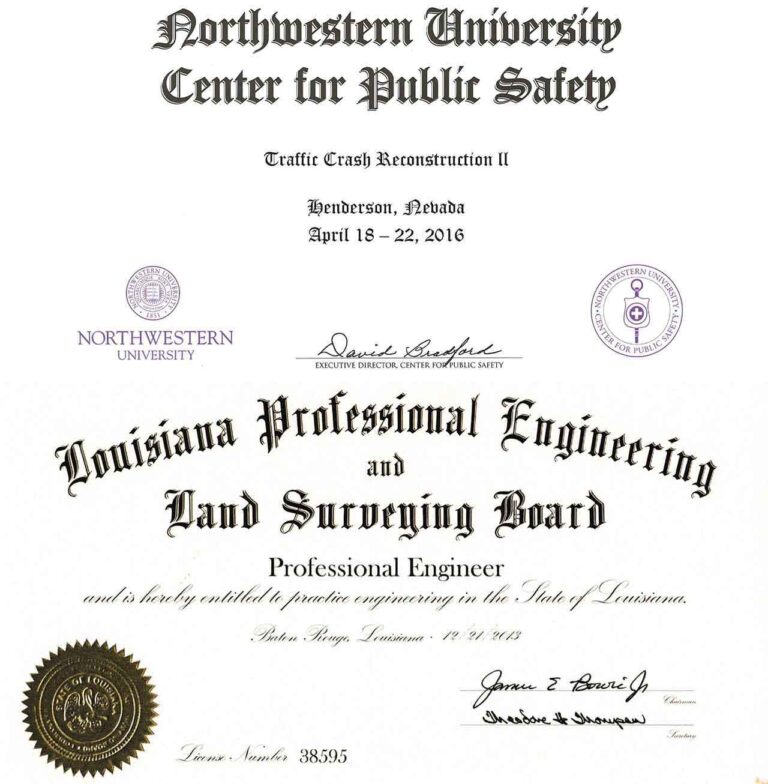Accident Reconstruction
Wet Road Collision
What happens when the parties involved in a wet road collision don’t agree on the events that led to the incident?
Accident Reconstruction Comes into Play
Investigate every Element of an Incident
The plaintiff claimed the defendant left their lane to crash into her while she was stopped at an intersection. The defendant alleged that the plaintiff pulled out in front of them. Because it was raining, no skid marks were left on the road itself, making it challenging to discern the position of the car being struck. Fortunately, there were tire tracks in the grass belonging to the defendant, which told the whole story of how both vehicles came to be in their ending positions.
The animation shows precisely where the plaintiff must have been located for the tire tracks to be in that location. This proves that the defendant did not stay in their lane, and did indeed wreck into the plaintiff.
Our animators are Traffic Crash Reconstruction Level II certified from Northwestern University, making them professionals at figuring out how an incident occurred as well as showing via an animation how the wreck transpired so that anybody could understand what was going on.
In addition to being Accident Reconstructionists, or animators have engineering degrees, and are professional engineers. This distinct advantage allows our animators to be very comfortable with the technical jargon of many industries, and provides a strong analytical background which is highly conducive for creating top-tier animations.


The initial impact caused a disc herniation in the plaintiff’s neck, disrupting the neurological pathways throughout her lower body. If that wasn’t enough, the plaintiff was pregnant. Her baby died because of the carelessness of the defendant. This animation shows the seriousness of the life-altering incident in vivid detail.
Accident Reconstruction
Legal Animation for Accident Reconstruction
You may ask why a legal animation would be helpful when reconstructing an incident. The answer is simple. Animations demonstrate liability by showing that a collision could have been avoided if a certain party avoided negligent behavior. For example, without the use of a visual aid, it would be challenging to depict to a jury the exact location of a vehicle in reference to a place they might have never been.
Oftentimes, we find that the facts in a case are complex and challenging to understand for the average person. In a society that is inundated with visual media, it’s critical to be able to teach them the ins and outs of a situation in a way that they’ll be able to understand. If you’ve heard somebody say “I’d have to see it to believe it,” then you know the extraordinary value of providing a visual display for the jury in order for them to understand.
Mark Dombroff says it best: “The varied uses of courtroom visual aids are limited only by your imagination. Legal graphic consultants and artists can be an important part of your team, in helping you highlight salient points, increase comprehension, illustrate the unknown and hard-to-imagine, permit audiences to digest large amounts of data quickly and easily, increase critical events in an evidentiary chain, add dramatic effect [and] make your presentation effective.”
Legal Graphics Help Jurors Decide
Jurors are more likely to sympathize with your client’s injuries when they see that the defendant’s actions were blatantly negligent. Adjusting points of view allows jurors to evaluate a driver’s actions from multiple angles. We work with such precision that our animations have actually been used as substantive evidence, not just demonstrative.
In our extensive experience developing crash reconstruction animations, we’ve done trucking collisions, multi-vehicle collisions, low-speed spine injuries, motorcycle collisions, and many other kinds of incidents. We perform FARO scanning, topographical mapping, forensic analysis, and nighttime visibility studies to determine the precise circumstances under which the incident occurred.
Fox Animation Engineering - Industry Leader for Legal Graphics
Our industry-leading legal graphics have been used by some of the top attorneys in the country. We’re able to achieve this level of excellence because our engineers are the animators. We have certified medical illustrators, medical practitioners, and 3D modeling engineers that collaborate together to create our state-of-the-art animations.


